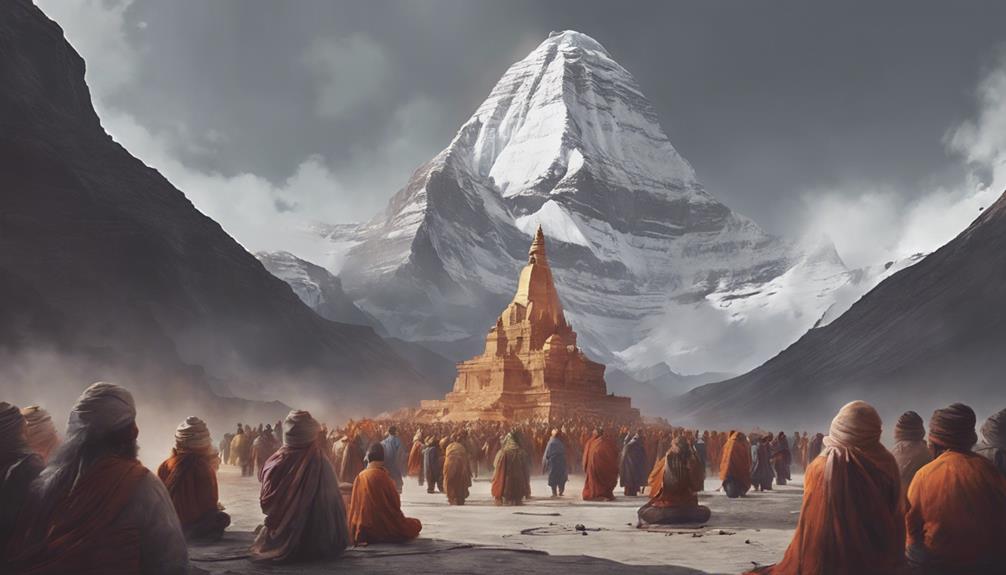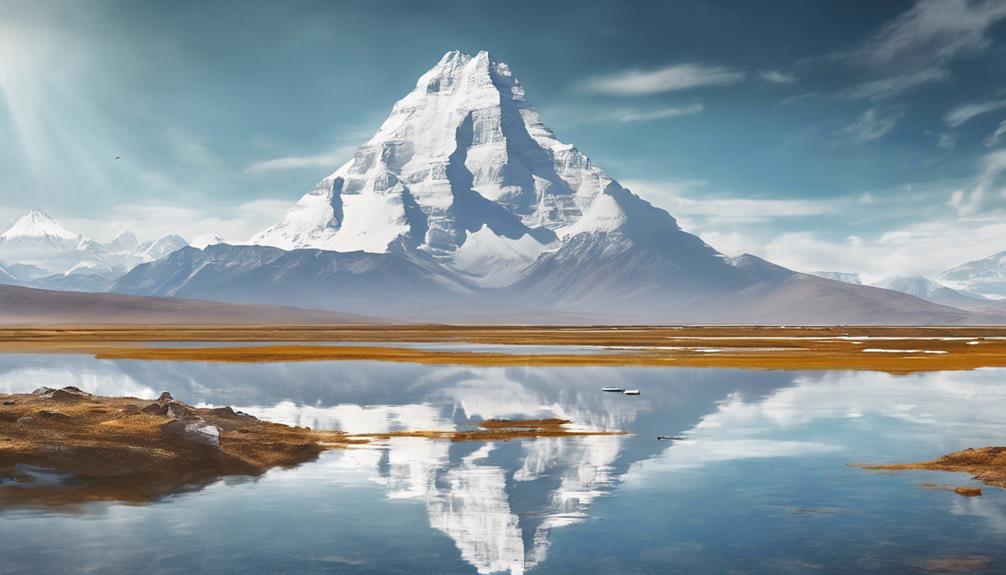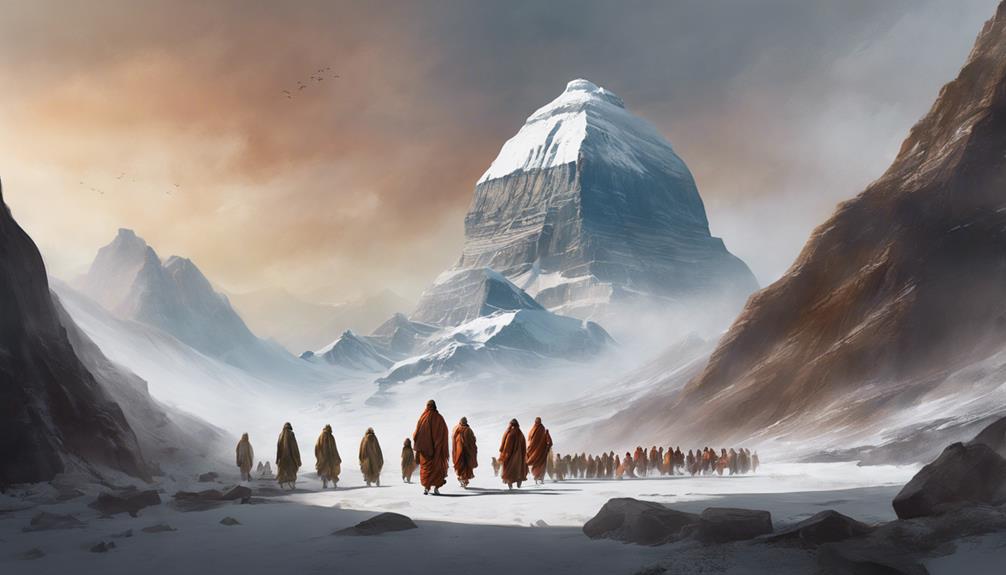Embrace the grandeur of Mount Kailash, where Lord Shiva resides as a symbol of divine presence and eternal truth, bridging the worlds of the physical and spiritual. This sacred mountain beckons you on a journey of self-realization and spiritual enlightenment, echoing ancient rituals and ceremonies that embody devotion and transcendence. The legends and folklore intertwined with Mount Kailash's essence whisper of mystical connections and spiritual significance that transcend earthly understanding. The mountain's significance in Hindu mythology is a proof of the enduring quest for truth and spiritual awakening that awaits those who seek its wisdom.
Table of Contents
Key Takeaways
- Mount Kailash is revered as Lord Shiva's abode, symbolizing divine presence and spiritual power.
- The mountain embodies eternal truth, spiritual pilgrimage, and enlightenment in Hindu culture.
- Mount Kailash signifies the connection between the spiritual and physical worlds, offering hope and spiritual significance.
- It is associated with ancient rituals, ceremonies, and pilgrimage routes signifying devotion and enlightenment.
- The mountain's beauty, imposing presence, and spiritual magnetism draw seekers of inner peace and enlightenment.
Origin of Mount Kailash
Rising majestically from the earth, Mount Kailash embodies the eternal connection between the spiritual domain and the physical world in Hindu mythology. This sacred peak isn't just a geological formation but a profound symbol of spiritual significance. In Hindu culture, Mount Kailash holds a deep-rooted cultural symbolism that dates back to ancient history. It's revered as the abode of Lord Shiva, the god of destruction and transformation. The mountain stands as a attestation to his divine presence and power.
Mount Kailash's towering presence isn't merely a physical entity but a manifestation of spiritual energy that resonates with devotees seeking enlightenment. Its sheer magnificence and untouched beauty inspire awe and reverence, drawing pilgrims from far and wide. The mountain's significance goes beyond its impressive height; it serves as a beacon of hope and a symbol of eternal truth in Hindu mythology. As you gaze upon Mount Kailash, let its ancient history and cultural symbolism guide you on a spiritual journey towards enlightenment and self-discovery.
Mythological Associations With Lord Shiva
Behold the awe-inspiring Cosmic Dance of Lord Shiva, symbolizing the eternal cycle of creation and destruction.
Witness the all-seeing Third Eye of Shiva, a potent symbol of wisdom, intuition, and divine insight.
Embrace the mystical essence of Lord Shiva's mythological associations, where each aspect reveals profound truths and spiritual teachings.
Shivas Cosmic Dance
In the timeless rhythm of the cosmos, Lord Shiva's Cosmic Dance embodies the eternal cycle of creation and destruction. As Shiva meditates, his dance symbolizes the cosmic energy that flows through all existence. Each movement represents the balance between the forces of life and death, creation and dissolution.
In this divine dance, Shiva's presence is both transcendent and immanent, encompassing the entire universe within his graceful movements. The rhythmic steps echo the heartbeat of the cosmos, reminding us of the impermanence of all things.
Through his Cosmic Dance, Lord Shiva teaches us to embrace change, to find beauty in transformation, and to surrender to the ever-turning wheel of existence.
Shivas Third Eye
With a gaze that delves beyond the physical domain, Lord Shiva's Third Eye embodies the mythological associations of divine knowledge and destruction. The Third Eye symbolism represents an inner vision that transcends the ordinary sight, allowing one to perceive the truth beyond illusions.
Through meditation and introspection, individuals seek to awaken their own Third Eye, tapping into Shiva's divine power and insight. This mystical eye isn't just a physical attribute but a metaphor for spiritual awakening and enlightenment.
Shiva's Third Eye is a reminder of the balance between creation and destruction, signifying the cyclical nature of existence where endings pave the way for new beginnings. Embrace the wisdom of the Third Eye, for it holds the key to discovering higher consciousness and understanding.
Spiritual Practices and Pilgrimages

Embark on a holy journey to Mount Kailash, where ancient rituals and ceremonies resonate with the divine energy of Lord Shiva.
Traverse the revered pilgrimage routes surrounding the mountain, each step a proof of spiritual devotion and enlightenment.
Discover the profound spiritual significance of Mount Kailash, a place where earthly and heavenly domains merge in a sacred union.
Sacred Rituals and Ceremonies
Journeying towards Mount Kailash unearths a spiritual domain woven with sacred rituals and ceremonies that beckon the devout seeker into the heart of divine communion.
Ritual practices and ceremonial traditions envelop the pilgrim in a domain where time dances with eternity, and the material world converges with the spiritual.
Devotional offerings and spiritual ceremonies conducted at the mountain's base resonate with an ancient energy that echoes the cosmic dance of creation and destruction.
Each ritual act becomes a thread in the fabric of existence, weaving together the past, present, and future into a seamless tapestry of devotion.
As you partake in these sacred practices, you align your soul with the cosmic rhythms that have reverberated through Mount Kailash since time immemorial.
Sacred Pilgrimage Routes
Through the sacred pilgrimage routes leading to Mount Kailash, seekers are called to embark on a transformative journey of spiritual awakening and divine connection. The spiritual journey towards this sacred mountain isn't simply a physical trek but a profound inner exploration, a transformative experience where the outer path mirrors the inner path.
Each step taken on these ancient routes is filled with sacred connections, paving the way for seekers to tap into the divine energy that flows through the majestic surroundings. As pilgrims traverse these paths, they shed layers of ego and attachment, purifying their intentions and opening their hearts to the spiritual revelations awaiting them at the journey's end.
The pilgrimage to Mount Kailash is a sacred odyssey where the physical landscape merges with the spiritual domain, guiding pilgrims towards profound self-discovery and divine communion.
Spiritual Significance Explained
In the domain of spiritual practices and pilgrimages, the divine essence of Mount Kailash beckons souls seeking profound connections and transformative revelations.
As you commence on the sacred journey towards this revered peak, the meditative practices intertwined with the rugged terrain offer a path for introspection and self-discovery.
Each step taken around the base of Mount Kailash becomes a prayer, a silent conversation with the universe, forging a deeper understanding of the self and the cosmos.
The pilgrimage itself is a metaphor for life's journey, filled with challenges and blessings, leading you towards a divine connection that transcends the physical domain.
Through these spiritual endeavors, Mount Kailash becomes not just a geographical marvel but a gateway to a higher consciousness, where the soul finds solace and enlightenment.
Symbolism of Mount Kailash

Upon Mount Kailash rests a profound symbolism that transcends earthly bounds, embodying the eternal connection between the divine and mortal domains. This majestic peak stands as a symbolic representation of spiritual pilgrimage, a sacred journey towards self-realization and enlightenment. Just as the mountain rises tall and unyielding, so too must one's spirit ascend above worldly attachments and desires to reach higher spiritual planes.
Mount Kailash's towering presence signifies the quest for inner strength and divine grace, urging pilgrims to tread the path of righteousness and purity. The circumambulation of this sacred peak isn't merely a physical act but a symbolic gesture of devotion and surrender to the cosmic forces that govern the universe.
As you gaze upon the snow-capped summit, let its grandeur and magnificence inspire you to seek the divine within yourself. Let Mount Kailash be a beacon of hope, guiding you towards spiritual awakening and inner peace. Embrace the symbolism it holds, for in its essence lies the key to discovering the mysteries of existence and attaining union with the divine.
Folklore and Legends Surrounding the Mountain
Embodied within the whispers of ancient winds are tales of divine beings entwined with the very essence of Mount Kailash, weaving a tapestry of folklore and legends that echo through the ages. Folklore traditions surrounding Mount Kailash speak of the mountain as the abode of Lord Shiva, the destroyer and transformer in Hindu mythology. It's believed that Mount Kailash is where Shiva resides with his divine consort, Goddess Parvati, symbolizing the eternal union of masculine and feminine energies.
Culturally significant, Mount Kailash is a beacon for spiritual seekers who set out on arduous pilgrimages to circumambulate the sacred peak. The spiritual practices undertaken by pilgrims along the ancient pilgrimage routes around the mountain are steeped in devotion and reverence for the divine powers believed to reside there. These pilgrimages aren't just physical journeys but also symbolic representations of inner transformation and enlightenment, reflecting the eternal cycle of birth, death, and rebirth.
The folklore and legends surrounding Mount Kailash serve as a reminder of the enduring spiritual legacy that continues to draw seekers from far and wide to experience the mystical allure of this sacred mountain.
Sacred Lakes and Rivers in the Region

Flowing through the sacred lands surrounding Mount Kailash are rivers and lakes intertwined with divine significance and spiritual essence. These sacred waters hold immense spiritual significance, believed to be infused with divine connections that transcend the spiritual domain. Pilgrims journey to these pristine lakes and rivers to partake in purification rituals, cleansing their souls and seeking spiritual renewal.
The tranquil waters of Lake Manasarovar, nestled near the base of Mount Kailash, are considered one of the holiest bodies of water in Hindu mythology. It's believed that a dip in its sacred waters can wash away sins and lead to spiritual enlightenment. Similarly, the flowing currents of the nearby Indus and Sutlej rivers are revered for their purity and role in sustaining life in the region.
These bodies of water serve as more than mere physical entities; they're conduits for spiritual reflection and divine connection, drawing seekers closer to the cosmic energies that permeate the sacred lands of Mount Kailash.
Architectural Marvels at Mount Kailash
Behold the ancient rock carvings etched by divine hands, the sacred temple structures standing as proofs of faith, and the hidden underground chambers veiled in mystery.
These architectural marvels at Mount Kailash whisper tales of devotion, strength, and the mystical presence that resonates through time.
As you journey through these hallowed sites, let the stones speak to your soul, revealing secrets of the cosmos and the eternal bond between the earthly and the divine.
Ancient Rock Carvings
Carved into the ancient rocks of Mount Kailash are intricate symbols and figures that stand as timeless proofs to divine craftsmanship and devotion. These rock art masterpieces, a validation of ancient history, depict stories of gods and goddesses, celestial beings, and mythical creatures.
Each carving is a sacred offering, a visual hymn etched in stone, inviting you to unravel the mysteries of the cosmos. As you gaze upon these ancient carvings, you're transported to a domain where time stands still, and the divine presence is palpable.
The rock art at Mount Kailash isn't just a physical representation; it's a spiritual gateway connecting the earthly domain to the celestial abode, where the gods themselves reside.
Sacred Temple Structures
Standing tall against the backdrop of Mount Kailash's majestic presence, the Sacred Temple Structures embody divine grace and architectural splendor, beckoning pilgrims to witness the celestial union of earth and heavens.
These sacred architectural marvels serve as conduits for spiritual practices, where devotees partake in rituals to connect with the divine. The intricate design of the temple structures reflects the deep-rooted spiritual significance of Mount Kailash, guiding pilgrims along revered pilgrimage routes to seek enlightenment and blessings.
Each pillar and carving holds a story, woven into the fabric of religious devotion, inviting visitors to experience a profound sense of peace and reverence. As you traverse through these hallowed grounds, let the Sacred Temple Structures guide your soul on a journey of faith and introspection.
Hidden Underground Chambers
Nestled beneath the sacred grounds of Mount Kailash lie the Hidden Subterranean Chambers, intricate architectural marvels veiled in mystery and reverence, awaiting discovery by those seeking spiritual enlightenment and divine connection.
These hidden chambers hold ancient mysteries that whisper tales of bygone eras, where time intertwines with eternity. The underground tunnels, like veins of the earth, carry within them archaeological secrets waiting to be unearthed by the curious and the faithful.
Each stone, each passage, is a piece of the cosmic puzzle, leading the way to a deeper understanding of the universe and one's place within it. As you venture into these underground domains, let the echoes of the past guide you towards the light of wisdom and enlightenment.
Influence on Hindu Art and Literature
In the domain of Hindu art and literature, Mount Kailash emerges as a revered symbol of divine connection and spiritual transcendence. The influence of Mount Kailash on Hindu art can be seen in intricate paintings and sculptures where its majestic presence symbolizes the abode of the gods and the center of the universe. Artists often depict Mount Kailash surrounded by celestial beings, portraying it as a place where earthly and heavenly domains meet, emphasizing its significance as a sacred pilgrimage site.
In Hindu literature, Mount Kailash is frequently mentioned in ancient texts and scriptures as the dwelling place of Lord Shiva, the supreme god of destruction and regeneration. Poets and writers draw inspiration from the mountain's towering presence to convey themes of strength, devotion, and ultimate liberation. The symbolism of Mount Kailash in Hindu literature mirrors its role in art, representing a spiritual journey towards enlightenment and the eternal pursuit of divine truth.
Contemporary Relevance and Cultural Impact

The enduring charm of Mount Kailash in Hindu mythology continues to shape contemporary beliefs and inspire cultural expressions that resonate deeply with the essence of spirituality and transcendence. Modern interpretations of Mount Kailash draw parallels between its symbolic representation as the abode of Lord Shiva and the pursuit of inner peace amidst life's chaos. Cultural celebrations, such as the annual pilgrimage around the sacred mountain, serve as a reminder of the historical significance of Mount Kailash in fostering unity and spiritual awakening among devotees.
The contemporary impact of Mount Kailash extends beyond religious boundaries, enchanting the hearts of individuals seeking solace and enlightenment. As a beacon of divine power and cosmic energy, Mount Kailash symbolizes the eternal quest for truth and self-realization. Its towering presence in the Himalayas serves as a constant reminder of the interconnectedness of all beings and the cyclical nature of existence. Through art, literature, and spiritual practices, Mount Kailash continues to inspire awe and reverence, leaving an indelible mark on those who seek to unravel its mystical secrets.
Mount Kailash in Global Perspective
Perched majestically amidst the Himalayas, Mount Kailash beckons to souls across the globe with its profound spiritual resonance and universal significance. This sacred mountain transcends geographical beauty, becoming a spiritual magnet that attracts seekers from all corners of the earth. Its Global connections are woven deeply into the fabric of various cultures, drawing pilgrims and adventurers alike to its awe-inspiring presence. Mount Kailash's Cultural significance extends far beyond borders, resonating with individuals who seek spiritual enlightenment and inner peace.
The allure of Mount Kailash lies not only in its physical grandeur but also in the spiritual connections it fosters among people worldwide. Its towering peak serves as a beacon of hope and a symbol of unity, transcending differences and uniting humanity in reverence for the divine. As visitors gaze upon its majestic slopes, they're drawn into a shared experience of wonder and awe, recognizing the profound impact this sacred mountain has on our collective consciousness. In this way, Mount Kailash stands as a proof to the power of spiritual magnetism and the enduring legacy of its Global connections.
Frequently Asked Questions
What Is the Geological Significance of Mount Kailash?
When you explore Mount Kailash's geological formations, you'll discover a blend of scientific marvel and spiritual significance. Its majestic presence resonates deeply within, connecting the earthly wonders to the divine mysteries of the cosmos.
Are There Any Endangered Species That Inhabit the Region Around Mount Kailash?
Endangered species like the snow leopard and Tibetan antelope inhabit the region around Mount Kailash. Conservation efforts are vital to protect these creatures and preserve the delicate balance of this sacred land.
How Has Modern Technology Impacted the Pilgrimage Experience to Mount Kailash?
In today's connected world, modern technology has transformed the pilgrimage to Mount Kailash. Virtual tours offer accessibility to all, while social media enhances connectivity, allowing a spiritual journey that transcends physical boundaries.
Are There Any Famous Personalities or Historical Figures Associated With Mount Kailash?
Famous historical figures and legends like Milarepa and Guru Rinpoche are tied to Mount Kailash, embodying its cultural significance and impact. Their presence adds spiritual depth and reverence to this sacred mountain.
What Are Some Lesser-Known Rituals or Ceremonies That Take Place at Mount Kailash?
At Mount Kailash, sacred rituals and traditions intertwine with spiritual practices. Pilgrims honor ancient customs, seeking divine connection. Ceremonies echo through time, carrying prayers, reverence, and devotion to the heart of this mystical domain.
Conclusion
As you stand in awe of Mount Kailash, know that its significance in Hindu mythology goes beyond mere physical presence. It's a sacred abode of Lord Shiva, a place where spiritual practices and pilgrimages find meaning.
The mountain's symbolism resonates in folklore and legends, inspiring architectural marvels and influencing art and literature. Mount Kailash's cultural impact is timeless, connecting humanity to divine spheres and reminding us of the eternal cycle of creation and destruction.